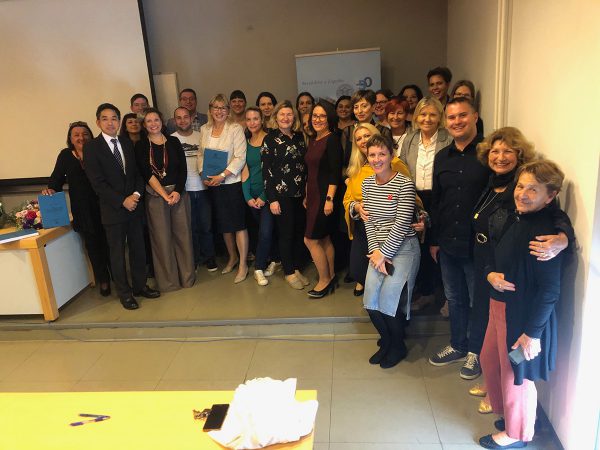![]()
Revitalisation of textile production of Spartium
Title: juncem L. – Development of autochthon Croatian
product: From weed to fabric
![]()
Main applicant: Zorana Kovačević, PhD student, assistant, University
of Zagreb Faculty of Textile Technology
Project funding: University of Zagreb Development Fund
Project Prof. Sandra Bischof, Ph. D., University of
Coordinator: Zagreb Faculty of Textile Technology
![]()
Project summary:
The main goal of this project is to make preliminary design and subsequently the original textile products from the Spartium junceum L. This almost forgotten culture on Croatian territory had its own significance. Through this project the results will be disseminated to the wider public, with an emphasis on the economic sector. By combining the artistic and scientific work the history of the Spartium junceum L., primarily in the Mediterranean countries, will be explored. Scientific investigation of its morphological and biological properties will be carried out as well as the traditional extraction of fibers (maceration) and their modification. Characterization of fibres for the purposes of obtaining high-quality autochthon fibers will be carried out. Such fibers will be used in manufacturing of original Croatian products in collaboration with partner institutions and the business sector. Revitalization of textile production from Spartium junceum L. is a long-term goal of this project, which could be realized upon its completion. Inclusion of small farms from the less developed parts of the Croatia contributes to the strategic objectives of improving the areas of special state concern.
Spartium Junceum L. is a shrub-like plant native to the Mediterranean region (Croatia, Italy, Spain, Greece, South of France, the Canary Islands, Turkey, etc.). It is very resistant to drought, so it is commonly found growing in regions that are rich with the sun, and have a little water. The name comes from the Greek word sparton meaning broom and English name is Spanish broom. In the past, the Greeks, the Romans and the Carthagians used it as raw material for manufacturing ropes, nets, bag, and even sails while our people used it also for making blankets, carpets, shoes, etc.
Manufacture of products from the Spartium was gradually declined throughout history and in the late 19th century completely ended. There were only few associations left in Croatia with the goal of maintaining and improving old craft, but only at the level of the tourist attraction. In recent times there is a reawakening of dormant economy in neighboring Italy.
Studying the latest literature, it was possible to predict future trends within the area, since several groups of scientists are finding some new and renewed properties of Spartium junceum L. Currently, Spartium is used in the paper industry as well as in the cosmetic industry because of its intense scent of flowers and essential oils from stems. It is also used in painting to create a canvas, and its yellow pigment is used as a supplement of artist oil paints. Ultimately, the largest application of Spartium is in the textile industry for various decorative items, clothing, technical textiles and biodegradable composite materials production.
Project objectives:
Tendency towards synthesis of science and art in order to obtain final product of higher aesthetic and practical value is common in the world. Thus, one of the most important tasks and goals (Goal 1) of this project is linking of scientific and artistic research with the aim of obtaining authentic Croatian products. Specifically, looking at papers in this field relatively weak link between artistic and scientific research can be observed. This linkage is in particular important in textile industry, and ultimately affects the quality of the product in its every respect. Unfortunately, we are witnessing too small number of research projects in artistic fields in Croatia. As we have already mentioned, the economy of Spartium junceum is left solely in the hands of small family manufactures. One of the goals of this research project is investigation of Spartium properties (Goal 2) and revitalization of existing production of textile products from the Spartium. In order to produce high quality textile products autochthon raw material selected from different Mediterranean regions was applied and the traditional maceration methods will be examined (Goal 3). Within the project, the traditional methods of fiber extraction from the Spartium junceum will be modified (Goal 4). Shorter processing times and higher quality of final product are tried to be achieved. It is also necessary to meet environmental requirements so, particular attention will be dedicated to the issue of wastewater treatment and utilization of waste materials in the production of new composite materials.
Within the project a logo of the Spartium junceum L. fibres and the preliminary design of the original Croatian souvenirs will be finalized (Goal 5). The achieved results will be presented through the TSRC Portal (http://www.ts-rc.eu), workshops, publications and media (Goal 6). Further activity within the project is one PhD dissertation which will combine all results and achievements. Final outcome is to encourage the creation of high-quality original products, arising from the scientific and artistic research, so as to strengthen co-operation between the academic community and the economy, and encourage the development of the Croatian economy.
Tab. 1: Project goals and results
| GOALS | RESULTS |
DESCRIPTION |
| Goal 1. | R.1 | Publication of artistic – scientific papers |
| Goal 2. | R.2 | Publication of scientific – artistic papers |
| Goal 3. | R.3 | Research secondment at INFMP |
Goal 4. |
R.4 | Modification of traditional maceration methods for Spartium junceum processing (possible patent application) |
| Goal 5. | R.5 | Logo design and preliminary design of souvenir from Spartium junceum L. |
|
Goal 6. |
R.6.1 | Project web page |
| R.6.2 | Workshops (1 educational and 1 dissemination) | |
| R.6.3 | Publication of flyers, brochures, papers (during project) and dissertation (after project ending) |
|
| R.6.4 | Presentations via media (TV, radio, newspapers) |
|
| R.6.5 | Exhibition | |
| R.6.6 | Book promotion |
Expected results:
Within project, cooperation of domestic and European scientists and artists is expected in order to revitalize textile materials production from Spartium junceum L. and renewal of old crafts. Thereat, joint publications of artistic research (R.1) and scientific research papers (R.2) are expected. Specifically, in order to modify the traditional method of maceration and creating authentic Croatian product, cooperation with domestic and foreign institutions like the Institute for Adriatic Crops and Karst Reclamation from Split, Croatia and the Institute of Natural Fibres and Medicinal Plants (INFMP) from Poznan, Poland is realized. Cooperation with the Ethnographic Museum in Split and the Archaeological Department of the City Museum Scaron;ibenik is also realized, which will lead us through the interesting history of the Mediterranean and Mediterranean culture in which Spartium junceum certainly belongs to. Within the project, research secondment in the period of 30 days at the Institute INFMP in Poland is planned (R.3). According to the literature (A. Premužić: Planned breeding of Spartium junceum L. on our coastal karst, 1948.) it was found that Spartium fibre has better properties than flax fibres. We will try to prove this fact by modern scientific methods of investigation. The traditional method of maceration in the sea will be modified in order to obtain better properties of the final textile products, such as improved hydrophilicity, dimensional stability, good dexterity, etc. (R.4). Guided by the knowledge from all around the world and Europe, we realized the importance of such project which would consolidate scientific and artistic research in order to revitalize traditional values. Artistic research is important to us in the development of the Croatian original product through the logo design and preliminary design of Spartium souvenirs (R.5). Furthermore, during the project work we expect a positive outcome of revitalization of small family manufacture with the aim of affirming traditional crafts. In order to make it easier to accomplish stated goal, within this project, the web site will be designed (R.6.1), educational and dissemination workshops (R.6.2) will be held, flyers, brochures and papers (R.6.3) will be published and all the research by then will be presented (R.6.4).
The project will be concluded with the exhibition in one of the partner’s museums (R.6.5) together with the promotion of a book titled “From weed to fabric” (R.6.6).
Obtained results:
Results 1 and 2: Publications:
1. Kovačević, Z.; Bischof, S.; Katović, D.: Brnistra – Od korova do tkanine, 6. znanstveno-stručno savjetovanje Tekstilna znanost i gospodarstvo (2013), Zagreb, Croatia
2. Kovacevic, Z.; Bischof, S.; Katovic, A.: Thermal and morphological properties of Spartium junceum fiber-reinforced green composites, International conference ICCE -20 (2012), Beijing, China
3. Kovačević, Z.; Bischof Vukušić, S.; Katović, D.: SEM characterization of advanced textile materials, International conference Matrib (2012), Vela Luka, Croatia
4. Kovačević, Z.; Bischof Vukušić, S.; Zimniewska, M.: Comparison of Spanish broom (Spartium junceum L.) and flax (Linum usitatissimum) fibre, Textile Research Journal 82 (2012) 17, 1786-1798
5. Kovacevic, Z.; Katovic, A.; Katovic, D.; Vrljicak, Z.; Bischof Vukusic, S.: Modern characterization of ancient materials from underwater archeological site, International conference Autex (2012), Zadar, Croatia
Result 3: Research secondment
Preliminary investigations of Spartium maceration were conducted in Poland at the Institute of Natural Fibres and Medical Plants (INFMP) from 18 th October 2010 to 10th December 2010. In order to more deeply explore issues of maceration, extension investigation was conducted within the project activities (T.4.1) in the period from 8th June 2012 to 17th June 2012 also at the INFMP Institute, Poznan, Poland.
Result 4: Modification of traditional methods
Traditional methods of maceration were modified in order to achieve a shorter processing time and better product in the end (R.4). One of the maceration modifications made during the project is maceration of Spartium junceum with sodium hydroxide and microwaves. Starting from the prior knowledge that the heated sodium hydroxide solution greatly facilitates the breakdown of the outer part of the stem and makes it easier to extract the fiber, we have tried to speed up the process, using a microwave oven.
Result 5: Design of logo and souvenir
The main goal of this project is to create autochthon product or souvenir made from Spartium junceum L. Considering the increasing internationalization of the University of Zagreb, the idea of the book came up that would be an excellent souvenir which could be presented to international partners by the employees of the University. The book will be printed in English. All of the scientific and artistic knowledge about Spartium collected during this project will be summarized in it. The book deals with the importance and use of Spartium through history to the present day. Special attention was paid to the overall usability of the plant: from seed, flowers, fibers, to the waste material that remains after the separation of fibers. The book contains a large number of original photographs that will present not only the beauty of Spartium but also the beauty of Mediterranean region (R.5).
Results 6: Dissemination
6.1. Project web page
6.2. Workshops:
– Educational workshop at TTF (Dated: 18th December 2012)
– Dissemination workshop
6.3. Publications: Book entitled From weed to fabric
6.4. Presentation at TV, radio, newspapers and other media:
(Znanstvena petica; Trenutak spoznaje; Poslovni dnevnik)
6.5. Exhibition in Šibenik
6.6. Promotion of book From weed to fabric
Partnering institutions:
Porart Association http://hr-hr.facebook.com/porart.zauvijekcajanka
City Museum of town Šibenik http://www.muzej-sibenik.hr
INFMP http://iwnirz.pl/
Opinions, findings and conclusions or recommendations contained in this material indicate the authors and do not necessarily reflect the view of the University.
![]()

